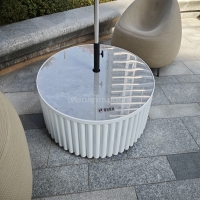Welcome to the website for landscape facilities products and knowledge.
What are the acoustic properties of different materials used in landscape tables for noise-sensitive areas?
Landscape tables in noise-sensitive areas require careful material selection to mitigate unwanted sound. Different materials exhibit unique acoustic properties that influence their effectiveness in noise reduction.
1. Wood: Natural wood, such as cedar or teak, offers moderate sound absorption due to its porous structure. It diffuses sound waves effectively, making it suitable for quieter environments. However, untreated wood may degrade over time, affecting its acoustic performance.
2. Metal: Metals like aluminum or steel are highly reflective, amplifying sound rather than absorbing it. While durable, they are less ideal for noise-sensitive zones unless paired with sound-dampening coatings or inserts.
3. Concrete: Dense and heavy, concrete blocks low-frequency noise but reflects higher frequencies. Textured or perforated concrete can improve absorption, making it a versatile choice for urban settings.
4. Composite Materials: Engineered composites, such as recycled plastic or fiberglass, balance durability and sound absorption. Their layered designs can be tailored to specific acoustic needs.
5. Fabric-Covered Tables: Some landscape tables incorporate acoustic fabrics or padding, significantly enhancing sound absorption. These are ideal for areas requiring high noise control, like courtyards or meditation spaces.
Choosing the right material depends on the specific noise challenges of the area. Combining materials, such as wood with fabric inserts, can optimize both aesthetics and acoustic performance. Regular maintenance ensures long-term effectiveness in noise-sensitive environments.
Related search:

Recommendation
Round metal tube border design table with tempered glass or granite countertop on the top.